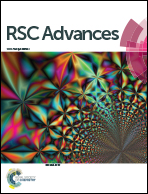Humidity sensor fabricated by inkjet-printing photosensitive conductive inks PEDOT:PVMA on a paper substrate
Abstract
In this study, 7-(4-vinylbenzyloxyl)-4-methylcoumarin (VM) and maleic anhydride (MA) were polymerized through free radical copolymerization to form a photosensitive alternating copolymer P(VM-alt-MA) (PVMA). PVMA was used as a soft template to achieve the oxidative polymerization of poly(3,4-ethylenedioxythiophene) (PEDOT). We obtained a stable PEDOT:PVMA photosensitive aqueous dispersion with an average diameter in the range of 140 to 210 nm. We then used this aqueous dispersion as the ink for fabricating humidity sensors through inkjet-printing on a paper substrate. The printed photosensitive conductive film PEDOT:PVMA could be cross-linked after photo-dimerisation of coumarin groups, leading to a small decrease of electrical conductivity, but also appreciable improvements in water resistance and sensor robustness. The humidity sensing ability of these PEDOT:PVMA/paper sensors was investigated by exposing them to a wide range of relative humidity, namely 11–97% at room temperature. These paper sensors could selectively and reversibly detect water vapor with a significant linear relationship. The response strength and the response/recovery time of the sensors show a substantial improvement compared with those of previous reports. The photo-dimerisation of PEDOT:PVMA improves the stability of humidity response and the response/recovery time of the sensors.


 Please wait while we load your content...
Please wait while we load your content...